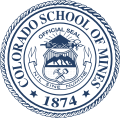 | |
 | |
 | |
| Established | 1873–74 |
|---|---|
| Location | General Research Laboratory (GRL) building, 1310 Maple St., Golden, CO 80401, United States |
| Coordinates | 39°45′07″N105°13′29″W / 39.75189°N 105.22484°W |
| Type | University museum, geology |
| Executive director | Renata Lafler |
| Website | mines.edu/museumofearthscience |
The Mines Museum of Earth Science, formerly the Colorado School of Mines Geology Museum, [1] is a geology museum located on the campus of the Colorado School of Mines, in Golden, Colorado, United States. It was established in 1877 by paleontologist and Mines' professor, Arthur Lakes. The first place to house the museum's collection was Jarvis Hall, which burnt down in 1878. While the museum awaited a new home, the collection continued to grow. Horace Patton was named Curator of the collection, still used primarily for teaching, in 1893. The collection was relocated to Guggenheim Hall in 1906, but upon Patton's retirement, the collection was relegated to storage. In 1940, upon completion of Berthoud Hall, home to Mines' geology department, the collection was unpacked by its newest Curator, J. Harlan Johnson and informally exhibited there until 2002.
Contents
In 2003, a space designed specifically for the museum was built as part of the GRL (General Research) building on campus. This 15,000 square foot space is the current home of the museum with more than 2,500 fossils, gemstones, meteorites, minerals, and mining artifacts. The name of the museum was changed from, the Colorado School of Mines Geology Museum, to Mines Museum of Earth Science, in 2019 during rebranding initiated by Executive Director, Renata Lafler.
Significant objects in the Museum's collection include: the Miss Colorado Crown, two lunar samples from the Apollo 15 and 17 missions, the Allison-Boettcher gold collection, the Wolcott silver pitcher and tray, an apatosaurus femur, an impressive assortment of fluorescent minerals, and the most comprehensive public collection of Colorado minerals in the world.
Mines Museum is open seven days a week and admission is free.

